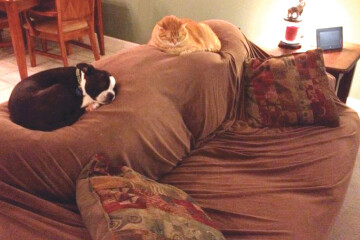Planting the Seeds of Spring

The catalogs started showing up right after Christmas. As I reached my gloved hands into my mailbox, I could see the bright glossy covers even though the late afternoon light was fading. My heart did a back flip and I thought “Spring is coming!” I know that’s a bit over zealous for Bozeman, Montana in early January, but the arrival of my seed catalogs always triggers happy thoughts of warm soil and fresh vegetables.
If you’ve ever tried to grow a garden in S.W. Montana, you know it’s not easy. It takes a great deal of time, energy, money and let’s be honest, some good luck, to get crops from seed to harvest without any loss. 2014 will be my fifth year planting a garden in the Gallatin Valley. I wish I could say I’ve perfected it by now but I know that’s not possible! Just when I think I’m prepared for anything, Mother Nature manages to throw something at me that I can’t handle: snow in June, hail storm in August, destructive winds in between, drought, voles, slugs, and the list goes on.
I start my gardening season in the middle of winter. When I’m stuck inside on a particularly snowy day, I’ll get all my seed catalogs together and spread them out on the dining room table, leafing through while I ooh and ahh over all the vivid close up images of flowers, fruits and vegetables that I know would never survive in my back yard. I run my hands over photos of giant plump strawberries, fuzzy peaches and juicy melons that take longer to get to harvest than time I have in our growing season. My boyfriend made some ambitious gardening attempts on his own before we combined households. As I point at raspberries, grapes and fruit trees, his answer is almost always the same “I tried it and they died.” We order our seeds from the Burgess catalog, which is a tradition my boyfriend’s mom passed down to him when he was growing up in Eastern Montana. We order in January or February but the seeds don’t arrive until later, usually in March when planting time is approaching. With the exception of the seeds, we use local resources for the rest of our gardening process. I’ve found our nearby hardware stores and nurseries to be fantastic resources for tips and tools to maximize our efforts.
At this point, we’ve managed to figure out what plants grow well for us: squash, broccoli, hot peppers, early crops like spinach, lettuce and peas, carrots, radishes, beans, and the ones that don’t: corn (too windy!), cabbages, melons, tomatoes. Oh how we try so hard to grow tomatoes every year, and out of five summers we’ve only had great success once. Last year we lost our whole crop, give or take a couple handfuls of cherry tomatoes, to a hail storm. We can have success with something one year (fifteen pumpkins!), but not the next.
After we decide what we’re going to attempt to grow this year, we order seeds. We start planting indoors in March, when the thought of anything growing in our frozen yard seems ridiculous. Then we wait. When the daily inspections of the seed starter trays finally reveal growth, we tend to get ahead of ourselves by imagining all the delicious salads and salsas we’ll make with our great bounty! As the seedlings grow, they graduate from their starter pots to larger ones that we make out of newspaper. This is the phase that can get overwhelming, as almost every flat surface in our house becomes covered with baby plants! And then we wait some more. More often than not, the plants are ready to go into the ground before the ground is ready for them. It’s always a gamble come May; do we risk it and put the plants out because it’s been warm? Or do we wait because it will most likely freeze and/or snow at least one more time. If we have to wait too long, the seedlings stop thriving. Most plants will get too tall for their pot and tip over as they strive to grow towards the sun, and the tomatoes start getting pale and spindly as they wait on our windowsills.
Once the plants are in the ground, we cross our fingers and hope they at least have a chance to take root before they are faced with severe weather. This often means leaving a few seedlings inside so they can replace their counterparts who don’t survive their first few days. This is usually the same time that we plant seeds in the ground for the “quick” crops like lettuce, peas and beans. Again this involves a lot of hoping for the right conditions, otherwise we end up with seeds that are blown away or rinsed away by heavy rain. Sometimes the greens will come up a few feet from where they were planted, I still count that as a success!
This first part of the growing season feels like the slowest. It’s usually chilly enough that we’re checking on the garden each evening and morning, covering and uncovering, watering, etc. This is often around the time I start seeing photos pop up on Facebook from my friends in other parts of the country who are already showing off their blossoming plants and early harvests. And then once we get into late June and the days are hot and sunny, the plants seem to double in size almost daily, winding up trellises and producing flowers. This is when it starts to feel real, like we did it! We have a garden. Then comes July into August, brutally hot, dry days and then we’re into September and worrying about frost already!
Even though it’s a lot of work and our season is short, gardening in S.W. Montana is still worth it. I find it therapeutic to spend an afternoon in the sun with my toes in the warm dirt, pulling weeds. It’s incredibly rewarding to come inside with a basket full of veggies for the night’s meal. Or better yet, to eat peas or tomatoes right off the vine. Food that I’ve grown myself tastes different and better than anything else.
The seed catalogs serve as a great reminder that spring will get here eventually. When I’m reminded of all the time I’ll spend outside on hot days I’m encouraged to enjoy the winter days a bit more. One of my favorite things about living here is the drastic differences between seasons. It helps keep me balanced. There’s always something to enjoy today, and other things to look forward to.
Ramona Graziul is an animal lover whose life has been greatly enriched by all the pets she has loved over the years. She enjoys taking her dogs on adventures in our beautiful Gallatin Valley. Her blog can be found at http://benicefollowrules.blogspot.com




